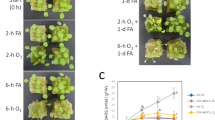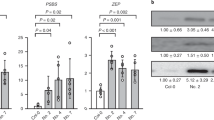Abstract
Plant stress caused by extreme environmental conditions is already a principal reason for yield reduction in crops1. The threat of global environment change makes it increasingly important to generate crop plants that will withstand such conditions. Stress, particularly stress caused by increased sunlight, leads to the production of reactive oxygen species that cause photo-oxidative cell damage2. Carotenoids, which are present in the membranes of all photosynthetic organisms, help protect against such light-dependent oxidative damage3. In plants, the xanthophyll cycle (the reversible interconversion of two carotenoids, violaxanthin and zeaxanthin4) has a key photoprotective role5 and is therefore a promising target for genetic engineering to enhance stress tolerance. Here we show that in Arabidopsis thaliana overexpression of the chyB gene that encodes β-carotene hydroxylase—an enzyme in the zeaxanthin biosynthetic pathway6—causes a specific twofold increase in the size of the xanthophyll cycle pool. The plants are more tolerant to conditions of high light and high temperature, as shown by reduced leaf necrosis, reduced production of the stress indicator anthocyanin and reduced lipid peroxidation. Stress protection is probably due to the function of zeaxanthin in preventing oxidative damage of membranes.
This is a preview of subscription content, access via your institution
Access options
Subscribe to this journal
Receive 51 print issues and online access
$199.00 per year
only $3.90 per issue
Buy this article
- Purchase on Springer Link
- Instant access to full article PDF
Prices may be subject to local taxes which are calculated during checkout




Similar content being viewed by others
References
Khush, G. Chair's introduction. Rice Biotechnology: improving yield, stress tolerance and grain quality. Novartis Foundation Symp. 236, 11–12 (2001)
Niyogi, K. Photoprotection revisited: genetic and molecular approaches. Annu. Rev. Plant Physiol. Plant Mol. Biol. 50, 333–359 (1999)
Cogdell, R. J. & Frank, H. A. How carotenoids function in photosynthetic bacteria. Biochim. Biophys. Acta 895, 63–79 (1987)
Yamamoto, H. Y., Nakayama, T. O. M. & Chichester, C. O. Studies on the light and dark interconversions of leaf xanthophylls. Arch. Biochem. Biophys. 97, 168–173 (1962)
Demmig-Adams, B. & Adams, W. W. Photoprotection and other responses of plants to high light stress. Annu. Rev. Plant Physiol. Plant Mol. Biol. 43, 599–626 (1992)
Cunningham, F. X. & Gantt, E. Genes and enzymes of carotenoid biosynthesis in plants. Annu. Rev. Plant Physiol. Plant Mol. Biol. 49, 557–583 (1998)
Sandmann, G. Genetic manipulation of carotenoid biosynthesis: strategies, problems and achievements. Trends Plant Sci. 6, 14–17 (2001)
Römer, S. et al. Elevation of the provitamin A content of transgenic tomato plants. Nature Biotechnol. 18, 666–669 (2000)
Ye, X. et al. Engineering the provitamin A (β-carotene) biosynthetic pathway into carotenoid-free rice endosperm. Science 287, 303–305 (2000)
Misawa, N. et al. Expression of an Erwinia phytoene desaturase gene not only confers multiple resistance to herbicides interfering with carotenoid biosynthesis but also alters xanthophyll metabolism in transgenic plants. Plant J. 6, 481–489 (1994)
Rock, C. & Zeevaart, J. The aba mutant of A. thaliana is impaired in epoxycarotenoid biosynthesis. Proc. Natl Acad. Sci. USA 88, 7496–7499 (1991)
Rissler, H. & Pogson, B. Antisense inhibition of the β-carotene hydroxylase enzyme in Arabidopsis and the implications for carotenoid accumulation, photoprotection and antenna assembly. Photosynth. Res. 67, 127–137 (2001)
Sun, Z., Gantt, E. & Cunningham, F. X. Cloning and functional analysis of the β-carotene hydroxylase of Arabidopsis thaliana. J. Biol. Chem. 271, 24349–24352 (1996)
Ruban, A. V., Lee, P., Wentworth, M., Young, A. J. & Horton, P. Determination of the stoichiometry and strength of binding of xanthophylls in the photosystem II light harvesting complexes. J. Biol. Chem. 274, 10458–10465 (1999)
Dixon, R. A. & Paiva, N. L. Stress-induced phenylpropanoid metabolism. Plant Cell 7, 1085–1097 (1995)
Xiang, C., Werner, B., Christensen, E. & Oliver, D. The biological functions of glutathione revisited in Arabidopsis transgenic plants with altered glutathione levels. Plant Physiol. 126, 564–574 (2001)
Winkel-Shirley, B. Flavonoid biosynthesis. A colorful model for genetics, biochemistry, cell biology and biotechnology. Plant Physiol. 126, 485–493 (2001)
Horton, P., Ruban, A. V. & Walters, R. G. Regulation of light harvesting in green plants. Annu. Rev. Plant Physiol. Plant Mol. Biol. 47, 655–684 (1996)
Li, X.-P. et al. A pigment-binding protein essential for regulation of photosynthetic light harvesting. Nature 403, 391–395 (2000)
Pogson, B., Niyogi, K., Björkman, O. & DellaPenna, D. Altered xanthophyll compositions adversely affect chlorophyll accumulation and nonphotochemical quenching in Arabidopsis mutants. Proc. Natl Acad. Sci. USA 95, 13324–13329 (1998)
Hurry, V., Anderson, J., Chow, W. & Osmond, B. Accumulation of zeaxanthin in abscisic acid-deficient mutants of Arabidopsis does not affect chlorophyll fluorescence quenching or sensitivity to photoinhibition in vivo. Plant Physiol. 113, 639–648 (1997)
Havaux, M. & Niyogi, K. The violaxanthin cycle protects plants from photooxidative damage by more than one mechanism. Proc. Natl Acad. Sci. USA 96, 8762–8767 (1999)
Young, A. J. & Lowe, G. M. Antioxidant and prooxidant properties of carotenoids. Arch. Biochem. Biophys. 385, 20–27 (2001)
Verhoeven, A. S., Bugos, R. C. & Yamamoto, H. Y. Transgenic tobacco with suppressed zeaxanthin formation is susceptible to stress-induced photoinhibition. Photosynthesis Res. 67, 27–39 (2001)
Havaux, M., Tardy, F., Ravenel, J., Chanu, D. & Parot, P. Thylakoid membrane stability to heat stress studied by flash spectroscopic measurements of the electrochromic shift in intact potato leaves: influence of the xanthophyll content. Plant Cell Environ. 19, 1359–1368 (1996)
Valvekens, D., Van Montagu, M. & Van Lijsebettens, M. Agrobacterium tumefaciens-mediated transformation of Arabidopsis thaliana root explants by using kanamycin selection. Proc. Natl Acad. Sci. USA 85, 5536–5540 (1988)
Noctor, G., Rees, D., Young, A. & Horton, P. The relationship between zeaxanthin, energy-dependent quenching of chlorophyll fluorescence and trans-thylakoid pH gradient in isolated chloroplasts. Biochem. Biophys. Acta 1057, 320–330 (1991)
Porra, R. J., Thompson, W. A. & Kriedemann, P. E. Determination of accurate extinction coefficients and simultaneous equations for assaying chlorophyll a and b extracted with four different solvents: verification of the concentration of chlorophyll standards by atomic absorption spectroscopy. Biochem. Biophys. Acta 975, 384–394 (1989)
Laby, R. J., Kincaid, M. S., Kim, D. G. & Gibson, S. I. The Arabidopsis sugar-insensitive mutants sis4 and sis5 are defective in abscisic acid synthesis and response. Plant J. 23, 587–596 (2000)
Hodges, D. M., DeLong, J. M., Forney, C. F. & Prange, R. K. Improving the thiobarbituric acid-reactive substance assay for estimating lipid peroxidation in plant tissues containing anthocyanin and other interfering compounds. Planta 207, 604–611 (1999)
Acknowledgements
We thank A. J. Young, E. H. Murchie, A. V. Ruban and M. Wentworth for discussions; P. Scholes for technical assistance; A. Moir for DNA sequencing and oligonucleotide synthesis; and P. Mueller-Moule and D. M. Hodges for advice on assay of lipid peroxidation. This work was supported by a grant from the UK Biotechnology and Biological Science Research Council.
Author information
Authors and Affiliations
Corresponding author
Ethics declarations
Competing interests
The authors declare that they have no competing financial interests.
Rights and permissions
About this article
Cite this article
Davison, P., Hunter, C. & Horton, P. Overexpression of β-carotene hydroxylase enhances stress tolerance in Arabidopsis. Nature 418, 203–206 (2002). https://doi.org/10.1038/nature00861
Received:
Accepted:
Issue Date:
DOI: https://doi.org/10.1038/nature00861
This article is cited by
-
Genes of carotenoid biosynthesis pathway in the moss Hylocomium splendens: identification and differential expression during abiotic stresses
Theoretical and Experimental Plant Physiology (2024)
-
Distinct growth patterns in seedling and tillering wheat plants suggests a developmentally restricted role of HYD2 in salt-stress response
Plant Cell Reports (2024)
-
COMT, CRTZ, and F3′H regulate glycyrrhizic acid biosynthesis in Glycyrrhiza uralensis hairy roots
Plant Growth Regulation (2023)
-
How do barley plants with impaired photosynthetic light acclimation survive under high-light stress?
Planta (2023)
-
The Anthurium APRR2-like Gene Promotes Photosynthetic Pigment Accumulation in Response to Salt Stress
Tropical Plant Biology (2022)
Comments
By submitting a comment you agree to abide by our Terms and Community Guidelines. If you find something abusive or that does not comply with our terms or guidelines please flag it as inappropriate.



